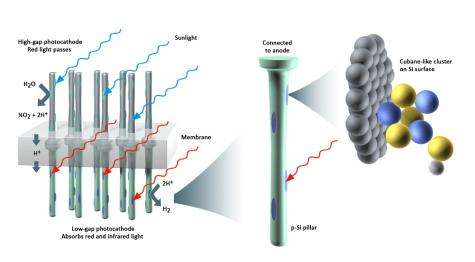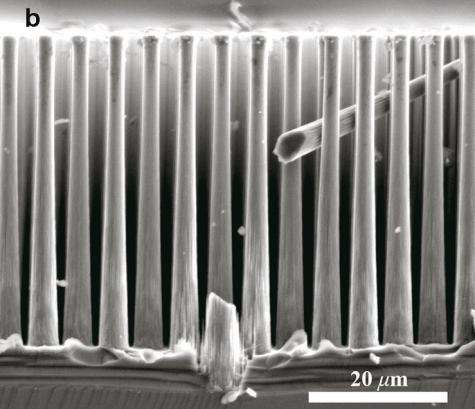May 10, 2011 feature
Cheap, abundant cathode material found for producing hydrogen fuel (w/ video)

(PhysOrg.com) -- By replacing catalysts made of expensive noble metals like platinum with cheaper, earth-abundant materials, researchers have taken a step toward enabling the large-scale production of hydrogen from sunlight and water. In a recent study, the researchers have demonstrated that catalysts made of molecular clusters based on molybdenum and sulphur can generate hydrogen from sunlight at rates comparable to those of platinum.
The researchers, led by Professor Ib Chorkendorff from the Technical University of Denmark, with coauthors from institutions in Denmark and the US, have published their study in a recent issue of Nature Materials.
As the researchers explain in their study, producing fuels from sunlight could lead to the development of a sustainable energy system, without the need for fossil fuels. Sunlight can be used to produce a variety of carbon-based solar fuels such as methanol and methane, but the simplest solar fuel to produce is hydrogen. In a typical solar hydrogen system, photovoltaic panels turn sunlight into electricity that is then used to extract hydrogen from water.
One type of solar hydrogen system is a chemical solar cell, which can harvest a large part of the solar spectrum and use it to generate hydrogen from water. Chemical solar cells consist of many pillars, with the top half of each pillar made of a photoanode that absorbs the blue part of the solar spectrum, and the bottom half made of a photocathode that absorbs the red part. When blue light is absorbed, it oxidizes water into oxygen and protons. The protons migrate through a membrane in which the pillars are embedded, ending up at the photocathode. As red light is absorbed, catalysts attached to the sides of the pillars reduce the protons to hydrogen.
As the researchers explain, the system depends on two reactions: the oxygen evolution reaction (OER) and the hydrogen evolution reaction (HER). In their study, the scientists focus exclusively on designing HER catalysts to perform the final step of reducing protons. Previously, platinum and other noble metals have been used as efficient HER catalysts, but they are too scarce and expensive for large-scale energy production.
To find an alternative HER catalyst, the researchers investigated biological organisms that have enzymes that produce hydrogen. By analyzing these natural catalysts, the researchers identified the properties that made them efficient, and then searched for related compounds that might work in a chemical solar cell. This process of theory, computation, synthesis, and testing led them to molybdenum sulfide – an inexpensive and abundant compound.

After applying small dots of the molybdenum sulfide onto the photocathode part of the pillars, the researchers tested the modified chemical solar cell. They found that, when the cell was exposed to light, it generated hydrogen with a solar-to-hydrogen efficiency of greater than 10%, which is comparable to the efficiency when platinum was used instead.
Serving as a HER catalyst, the new compound addresses only half of the water-splitting process. In the future, the researchers also hope to find a cheap, abundant material for an OER catalyst. Although they predict that this may be even more difficult than finding the HER catalyst material, they plan to use the same methods to approach this challenge.
More information: Yidong Hou, et al. “Bioinspired molecular co-catalysts bonded to a silicon photocathode for solar hydrogen evolution.” Nature Materials. Advance Online Publication. DOI: 10.1038/NMAT3008
Participating institutions:
The Center for Individual Nanoparticle Functionality, CINF, www.cinf.dtu.dk
Catalysis for Sustainable Energy, CASE, www.case.dtu.dk
SLAC National Accelerator Laboratory, www.slac.stanford.edu
SUNCAT, today.slac.stanford.edu/feature/2010/suncat.asp
Copyright 2011 PhysOrg.com.
All rights reserved. This material may not be published, broadcast, rewritten or redistributed in whole or part without the express written permission of PhysOrg.com.

















